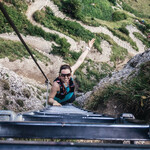

Nothing But Cheese
The weeks of the Agricultural Festival in Kleinwalsertal in September and October are the perfect occasions to ponder on the subject of cheese. Why not write about a typical cheese dish?!
There is scarcely any other dish that is scrutinised as much as this in whole of the Walser Valley (and the rest of Vorarlberg and Allgäu). The best way to cook it is following the normal methods used by your mother or grandmother. This means that from the outset the standard has been set very high by the rest of us. This dish will have been very well thought out when it is served in a restaurant or when you are invited to dinner. The plate will then be viewed with a questioning eye. Its shape should not be too elongated; it should ideally be small and round; the cheese should definitely be stringy; it should not be too dry; and you must certainly never forget to add onions which must have a deep caramelised flavour and be just the right consistency. Opinions also differ on what constitutes the perfect accompaniment to the dish; one person would opt for a potato salad, another would choose a green salad and someone else would prefer to eat it with apple sauce. We are obviously talking about the original Walser Käsknöpfle; the correct name in the local dialect is Chääschnööpfle.
Which came first? The Vorarlberger Knöpfle or the Swabian Spätzle? How did they come to be a speciality in Kleinwalsertal? Did they arrive over the mountains from Vorarlberg as Knöpfle or from the Allgäu as Spätzle? There are references on the internet to the Vorarlberger Schwabenkinder (Swabian children). This is the name that was used for children belonging to alpine farmers who lived in Vorarlberg (or also Tyrol, Südtirol (South Tyrol) and Switzerland) who from the 17th to the 20th centuries would migrate to Swabia each spring to find seasonal work so that they could help to support their families. One theory suggests that they brought the recipe for classic Spätzle back home with them which then became Käsknöpfle in Vorarlberg.
Whichever way they found their way to us, one thing is certain, you will definitely find a Knöpfle grater in every Walser household and genuine Käsknöpfle should be found on every menu.
If anyone should know the answer to the question, ‘Which came first the Knöpfle or the Spätzle?’, then I would love to hear any explanations you may have in the comments section.




Share page...
...and tell others